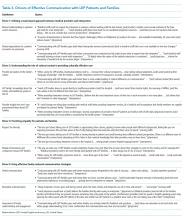Inpatient Communication Barriers and Drivers When Caring for Limited English Proficiency Children
BACKGROUND: Achieving effective communication between medical providers and families with limited English proficiency (LEP) in the hospital is difficult.
OBJECTIVE: Our objective was to identify barriers to and drivers of effective interpreter service use when caring for hospitalized LEP children from the perspectives of pediatric medical providers and interpreters.
DESIGN/ PARTICIPANTS/ SETTING: We used Group Level Assessment (GLA), a structured qualitative participatory method that allows participants to directly produce and analyze data in an interactive group session. Participants from a single academic children’s hospital generated individual responses to prompts and identified themes and relevant action items. Themes were further consolidated by our research team and verified by stakeholder groups.
RESULTS: Four GLA sessions were conducted including 64 participants: hospital medicine physicians and pediatric residents (56%), inpatient nursing staff (16%), and interpreter services staff (28%). Barriers identified included: (1) difficulties accessing interpreter services; (2) uncertainty in communication with LEP families; (3) unclear and inconsistent expectations and roles of team members; and (4) unmet family engagement expectations. Drivers of effective communication were: (1) utilizing a team-based approach between medical providers and interpreters; (2) understanding the role of cultural context in providing culturally effective care; (3) practicing empathy for patients and families; and (4) using effective family-centered communication strategies.
CONCLUSIONS: Participants identified unique barriers and drivers that impact communication with LEP patients and their families during hospitalization. Future directions include exploring the perspective of LEP families and utilizing team-based and family-centered communication strategies to standardize and improve communication practices.
© 2019 Society of Hospital Medicine
Barrier 1: Difficulties Accessing Interpreter Services
Medical providers (physicians and nurses) identified the “opaque process to access [interpreter] services” as one of their biggest challenges when communicating with LEP families. In particular, the process of scheduling interpreters was described as a “black box,” with physicians and nurses expressing difficulty determining if and when in-person interpreters were scheduled and uncertainty about when to use modalities other than in-person interpretation. Participants across groups highlighted the lack of systems knowledge from medical providers and limitations within the system that make predictable, timely, and reliable access to interpreters challenging, especially for uncommon languages. Medical providers desired more in-person interpreters who can “stay as long as clinically indicated,” citing frustration associated with using phone- and video-interpretation (eg, challenges locating technology, unfamiliarity with use, unreliable functionality of equipment). Interpreters voiced wanting to take time to finish each encounter fully without “being in a hurry because the next appointment is coming soon” or “rushing… in [to the next] session sweating.”
Barrier 2: Uncertainty in Communication with LEP Families
Participants across all groups described three areas of uncertainty as detailed in Table 2: (1) what to share and how to prioritize information during encounters with LEP patients and families, (2) what is communicated during interpretation, and (3) what LEP patients and families understand.
Barrier 3: Unclear and Inconsistent Expectations and Roles of Team Members
Given the complexity involved in communication between medical providers, interpreters, and families, participants across all groups reported feeling ill-prepared when navigating hospital encounters with LEP patients and families. Interpreters reported having little to no clinical context, medical providers reported having no knowledge of the assigned interpreter’s style, and both interpreters and medical providers reported that families have little idea of what to expect or how to engage. All groups voiced frustration about the lack of clarity regarding specific roles and scope of practice for each team member during an encounter, where multiple people end up “talking [or] using the interpreter at once.” Interpreters shared their expectations of medical providers to set the pace and lead conversations with LEP families. On the other hand, medical providers expressed a desire for interpreters to provide cultural context to the team without prompting and to interrupt during encounters when necessary to voice concerns or redirect conversations.
Barrier 4: Unmet Family Engagement Expectations
Participants across all groups articulated challenges with establishing rapport with LEP patients and families, sharing concerns that “inadequate communication” due to “cultural or language barriers” ultimately impacts quality of care. Participants reported decreased bidirectional engagement with and from LEP families. Medical providers not only noted difficulty in connecting with LEP families “on a more personal level” and providing frequent medical updates, but also felt that LEP families do not ask questions even when uncertain. Interpreters expressed concerns about medical providers “not [having] enough patience to answer families’ questions” while LEP families “shy away from asking questions.”







